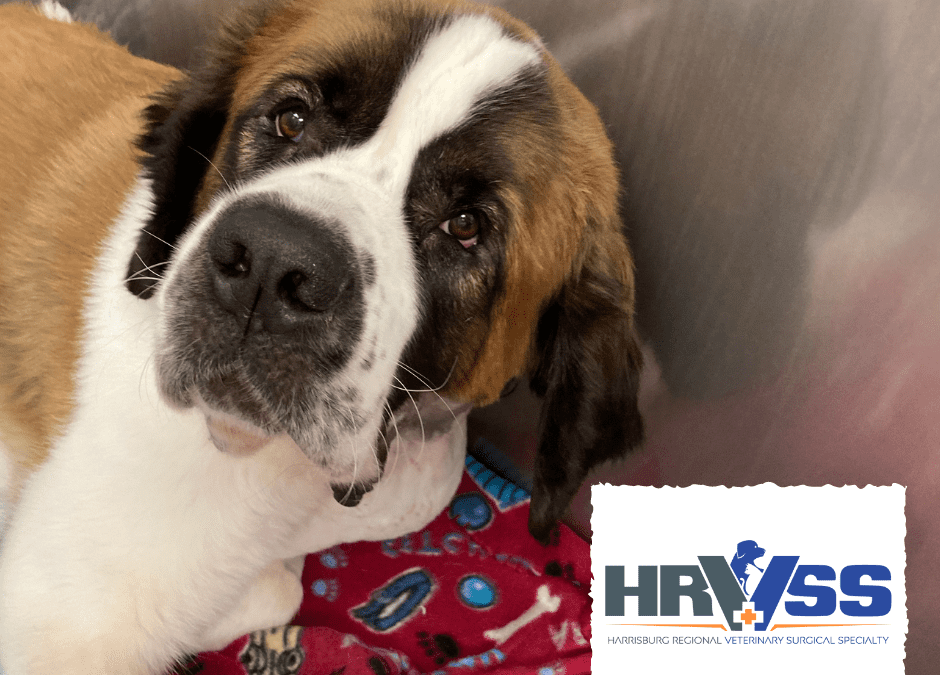“I am rushing Everly to the emergency clinic. Her breathing is labored. She is vomiting foam. And her lips and gums are blue.”
This was the panicked call Everly’s owner received from the manager of a boarding facility in Pennsylvania, where her dog had been dropped off during her vacation… in Florida.
Everly, a sweet 3-year-old, 120-pound St. Bernard, “had always been a very loud breathing dog,” her owner recalls. “This was our first giant breed dog, so we just figured it was how a Saint Bernard sounds.”
Here is a video of her struggling to breathe before surgery:
After being stabilized with oxygen and a sedative, Everly was tentatively diagnosed with laryngeal paralysis, or “lar par.”
The larynx (or voice box) is supposed to close off after we inhale, open up when we inhale, and again close off when we eat or drink to prevent “swallowing the wrong way.”
When the larynx is paralyzed, the patient cannot get enough oxygen on board, and cannot expel CO2 or heat efficiently. So they typically can be “blue” and overheated.
The poor dog literally suffocates.
It’s a very stressful and life-threatening situation.
The only good solution is surgery.
There was another problem. “There weren’t any available surgery appointments at the two practices the emergency clinic had recommended.”
So Everly’s owner, determined to save her dog, found HRVSS.
She recalls: “I contacted HRVSS right away, and they got Everly in very quickly.”
On exam, Everly definitely sounded like she had lar par.
Before anything, we took chest X-rays to make sure there was no unknown condition and to eliminate the possibility of a type of pneumonia called aspiration pneumonia.
The next step was to confirm the suspicion of a diagnosis of lar par.
Under light sedation, the mouth is opened and the larynx is observed. With Lar Par, the folds of the larynx will not open and close as the patient breathes in and out. Everly’s folds remain closed – they were paralyzed.
Now, lar par is most commonly seen in Labs over 10 years of age.
So I suspected Everly, who had had noisy breathing her whole short life, could have been born with lar par, which is rare.
Then we needed to fix the problem.
So we moved Everly from light sedation to general anesthesia.
Meanwhile, her owner remembers: “We were terrified of her going under anesthesia knowing she wasn’t breathing well on her own. We could either lose her to not breathing or we could possibly lose her on the operating table. It was a chance we were willing to take for our girl.”
We then took Everly to surgery. The “tie back” procedure involves placing 2 heavy nylon sutures (i.e. permanent) to open up the left side of the larynx.
Our gentle giant recovered smoothly from anesthesia, under careful supervision, and eventually went home to rest and heal for 2 months.
Here is a video of her shortly after surgery:
Her owner said: “I noticed an immediate difference when I picked her up after surgery. She was so quiet! She didn’t even snore at night anymore!”
We got back in touch 1 year and 4 months later. Everly was still doing well.
Her owner commented: “Now she is almost 5 years old, and she is doing very well!”
If you would like to learn how we can help your pet with safe surgery and anesthesia, please contact us through www.HRVSS.com
Never miss a blog by subscribing here: www.HRVSS.com/blog
Phil Zeltzman, DVM, DACVS, CVJ, Fear Free Certified

